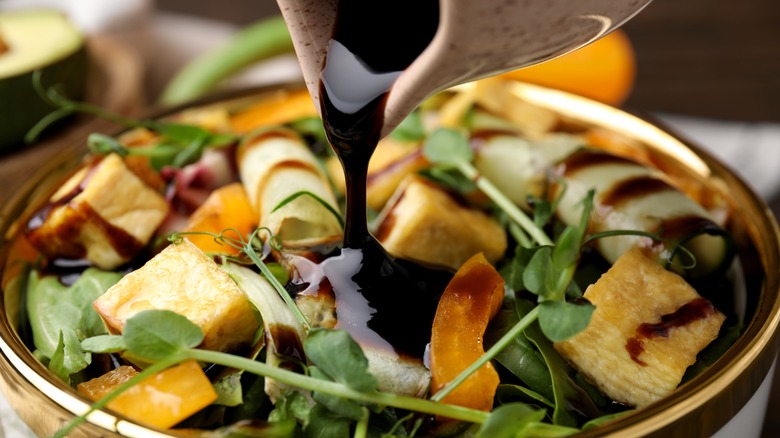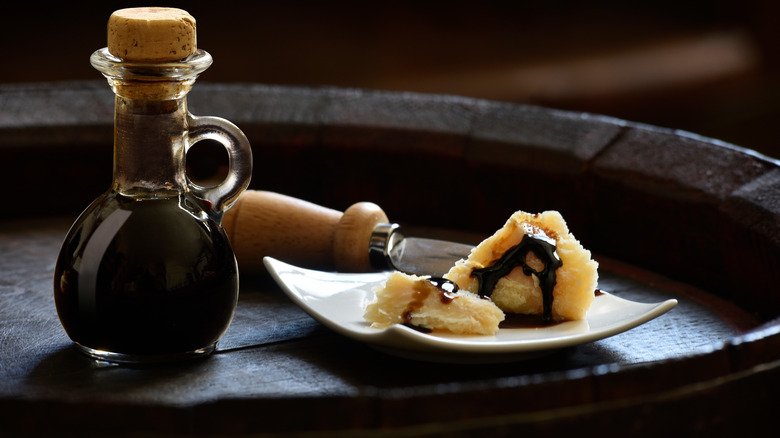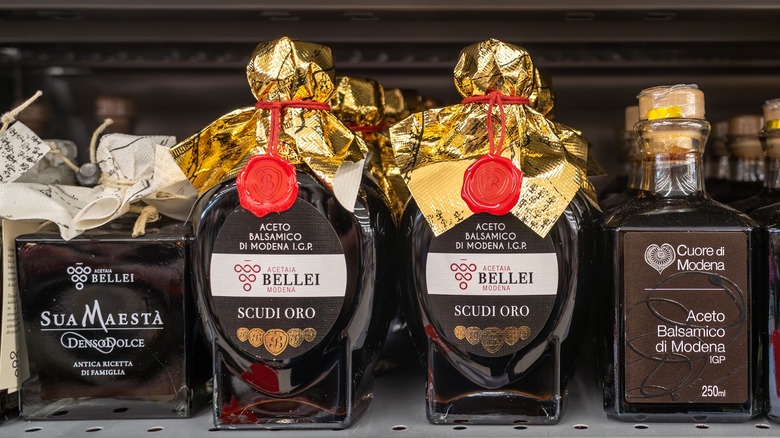Sorry, But Your Balsamic Vinegar Is Probably Fake
Once revered as a vinegar fit for kings and now readily available in supermarkets the world over, balsamic vinegar is no longer the rare ingredient it once was. Or, so it may seem. The signature tarty sweet flavor and velvety mouthfeel of balsamic — amazing for salad dressings, caramelized onions, and marinades — might come out of a bottle that says "balsamic vinegar," but what it contains is most likely not the real McCoy.
Traditional balsamic vinegar has just one ingredient: grapes, and to be considered bonafide can only originate from Reggio Emilia or Modena, Italy. Aged in barrels for anywhere between 12 to 25 years, it gets the exalted D.O.P. (Denominazione di Origine Protetta) stamp, signifying it is the product of a specific region that has passed several quality control checks by local experts. There are versions of balsamic vinegar available that are considered more-or-less authentic, namely those that come with protected geographic designation, but what you will find outside of the E.U., and high-end specialty shops elsewhere are likely mass-market imitators.
You (or rather your wallet) will know when you're about to get the real stuff because it will not be cheap. While a few dollars might allow you to snag a bottle of something balsamic-y, for something pressed and aged on the Italian peninsula, be prepared to shell out dozens of dollars ... per ounce. As far as taste, it's not too hard to distinguish between these varieties based on the depth of flavor, simplicity of ingredients, and, sometimes, how it's being served.
Few have tasted the real black gold
The most authentic balsamic vinegar is called "aceto balsamico tradizionale," aged at least 12 years. The only variety considered even finer is called "extravechhio" and spends twice that long aging in barrels of oak, mulberry, cherry, juniper, and other woods that impart added complexity. Traditional balsamic vinegar is made out of what is known as grape must; it's an ancient regional production method that includes the juice skin, stem, and seeds of the grape and is a big part of what distinguishes it.
Traditionally, the birth of a baby girl was celebrated by initiating a new set of barrels that would house a batch of grape must destined to become extravechhio. By the time she turned 25, the must, now transformed to "black gold," could be used as a dowry. Procuring a bottle of traditional balsamic vinegar can seem like an investment even now, with a 100 ml (about 3 ounces) bottle fetching several hundred dollars, but the experience of savoring it is worth it.
Traditional balsamico is not used in cooking, lest the heat disperses its bouquet. Instead, it is paired with fresh berries and creamy desserts or even served atop slivers of authentic Parmigiano-Reggiano cheese. When used in recipes, it is drizzled over dishes as diverse as risottos and grilled meats just before serving. In flavor, traditional balsamico has a complex sweetness and subtle tanginess as opposed to its mass-produced counterpart's robust and more acidic bite.
A quick guide to balsamic vinegar
Raw grape juice that was reduced over a fire and honey were sweeteners in ancient Europe. When the juice of grapes is left in wood barrels for long periods, it becomes acetified and turns into vinegar. Balsamic nicely straddles the two categories — for what the Italians refer to as agrodolce — as a sweet yet mellow acidic drizzle. Though early balsamic vinegar was used as a medicine, it quickly captured the attention of aristocratic tastebuds and became a staple of royal kitchens. Fast-forward a couple of centuries and the growing popularity of balsamic gave rise to a multitude of substitutes, and thus the wide spectrum in the quality of modern versions.
Top shelf, aged balsalmico is great if you can get it, but keep an eye out also for another designation that signifies high quality: I.G.P. or Indicazione Geografica Protetta This kind of balsamic is also processed in Modena, but undergoes a much shorter preparation period of just about two months. It may even contain additives to make it taste more like its traditional counterpart. A much wider variety of I.G.P. balsamic vinegar is available, but those with the fewest ingredients tend to be the most authentic. While most other varieties will likely contain grape (generally a base of red wine vinegar) they tend to be watery, lacking in the fruity flavor or aged balsamic, and are free of umami and sweet notes of wood. It might bear the same or a similar name, but there is a world of difference.


